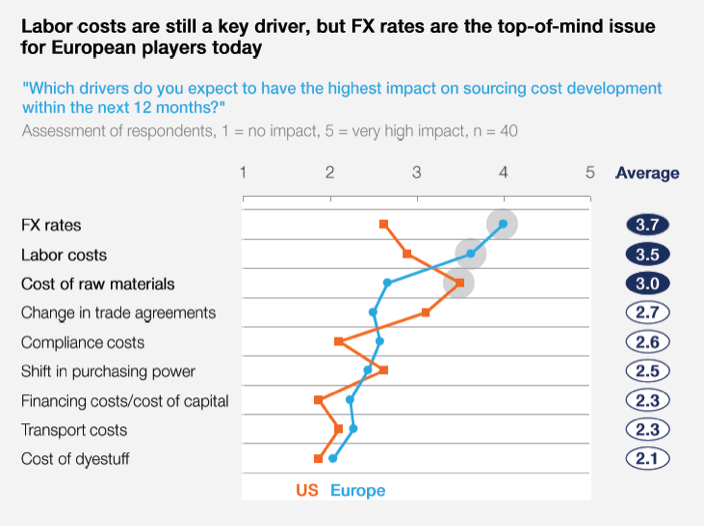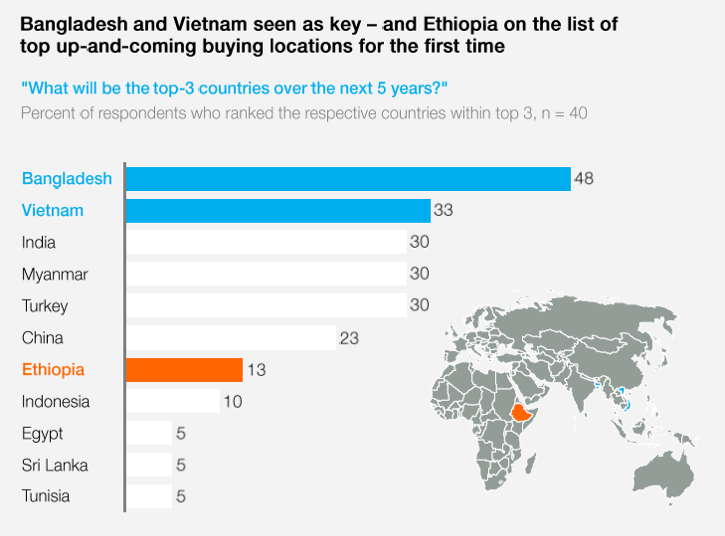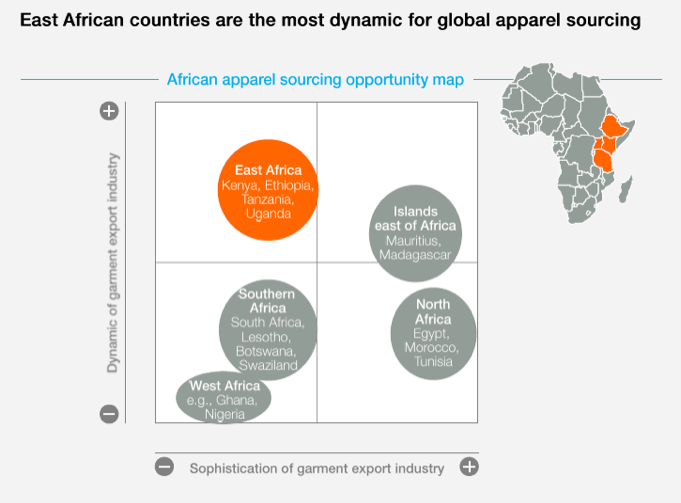GET IN TOUCH
- Please wait...

According to the International Trade Statistics 2015 released by the World Trade Organization (WTO) last month, Bangladesh is still the third-largest clothing manufacturer (5.10%), with a growth rate of 4.60%. China and the EU are still the biggest manufacturers, with market shares of 38.60% and 26.20% respectively. The other two leading manufacturers, Vietnam and India, are seeing increasing market shares with their growth rates at 14%. (Source: The Financial Express)
Globally the apparel industry is seeing a lot of changes which is redefining the industry dynamics. Factors like financial policies, exchange rate volatility and low-interest rates in Europe and the US, and low oil prices throughout the world have impacted the sourcing in the apparel sector. According to a survey of 40 Chief Purchasing Officers by McKinsey and Company, prices will increase although inflation rates are historically low. These along with factors like stagnating apparel market in the developed world, expected shift in the future consumer market, fast fashion, and increasing need for compliance is forcing the apparel players to rethink their strategies.

Source: McKinsey CPO Survey
In recent years, Africa has received a great deal of attention and is expected to rise as a top sourcing country in the coming years. But China is still the first destination choice. Top three sourcing countries after China – Bangladesh, Vietnam, and India – export only one-third of the dollar value of China’s exports. However, the scenario is slowly changing. Buyers are increasingly starting to diversify into low-cost Asian and African sourcing countries. China is focusing more on catering to its growing middle class, and many of China’s garments manufacturers are looking to open facilities in Cambodia, Vietnam, and Myanmar. But for the international CPOs, Bangladesh remains the top future sourcing destination. (Source: McKinsey and Company)

Source: McKinsey CPO Survey
Even though Bangladesh, Vietnam, and India are expected to grow, unlike their nearest competitors, most Sub-Saharan countries are still mired by political uncertainties. Population trends point toward sub-Saharan Africa, as it is expected to enjoy a demographic dividend over the next 20 years, while China’s labor pool could shrink by one-fifth over the next 50 years. Proximity sourcing has developed into a serious alternative for apparel companies, and the CPOs expect near-shoring to increase over the next five years. With the help of legislation and incentives provided by the government along with the increase in the working-age population, African countries can prove to be major contenders in the future years. But first, they would have to deal with many problems which include a lack of skilled employees, poor infrastructure, and the high lead time that comes with it.

Source: McKinsey CPO Survey
So what do these mean for Bangladesh? While our country is a CPO favorite and meant to grow more than any other country, we facing various challenges which are keeping our potential in check, and in instances, driving them down. The complications resulting from political instability increase our lead time when procuring raw materials and also make it difficult for us to transport our products once production is completed. Fast fashion is an area where we should tread gently since our manufacturers usually get large orders, and the small-batch sizes and quick responses that fast fashion has brought are not something they are habituated with. The slowdown in growth from 13% in 2013 to 4.60% in 2014 means that the productivity and efficiency in this industry have decreased. This means that we are not in a position to easily benefit from the falling Chinese and EU exports, especially since our current competitors are performing so well and there are upcoming destinations that are drawing so much attention
So what does the future hold for Bangladesh? That depends on the efforts of our suppliers as well as the government. If we stay on our current course Vietnam and India may soon cross our market shares. Suppliers should focus on their weaknesses, like establishing clear standards for labor and environmental compliance. They should also focus on improving the skills of management and providing training to workers, and also incorporating more automation in the production process. The government can attempt to stabilize the political situation, as well as specific infrastructural developments for the RMG sector, which can reduce the lead time as well as costs, transportation, and others. (Source: McKinsey and Company)
Bangladesh is already on the radar of the RMG buyers as a strong player, and won’t be replaced by other markets as a valuable sourcing destination soon. But the competition between the sourcing countries is sure to increase in the near future. In order to make the best of what we have, we should concentrate on overcoming the challenges to our growth and increasing the value-added to our production process. Only then would Bangladesh’s RMG sector be able to play up to its full potential.
This research was conducted by Maruf Hassan, a Junior Associate of LightCastle Partners.
Our experts can help you solve your unique challenges
Stay up-to-date with our Thought Leadership and Insights